30 Ducks with White Wings (With Pictures)
When people are asked to name ducks with white wings, the first answers are often the White-winged Duck or White-winged Scoter—mainly because their names make it obvious. But did you know that there are over 40 duck species with white on their wings? Not all of them have fully white wings, but many show white patches, stripes, or sections that become visible in flight or at rest.
To show just how common this feature is, I’ve put together a list of 30 of the most well-known ducks with white wings. Some of them might surprise you—you may have never noticed their wing markings before.
Let’s dive into the list and explore these fascinating species.
- 1. White-winged Duck
- 2. White-winged Scoter (Male)
- 3. Bufflehead (Male)
- 4. Black-bellied Whistling Duck
- 5. Tufted Duck (Male)
- 6. Common Merganser (Male)
- 7. Canvasback (Male)
- 8. Ring-necked Duck (Male)
- 9. Common Shelduck
- 10. Paradise Shelduck
- 11. Ruddy Shelduck
- 12. Greater Scaup
- 13. Lesser Scaup
- 14. Common Goldeneye
- 15. Barrow’s Goldeneye (Male)
- 16. Bufflehead (Male)
- 17. Smew
- 18. Red-breasted Merganser
- 19. Long-tailed Duck
- 20. Gadwall
- 21. American Wigeon (Male)
- 22. Eurasian Wigeon (Male)
- 23. Common Eider
- 24. King Eider
- 25. Steller’s Eider
- 26. Mallard (Male)
- 27. Ancona Duck
- 28. Magpie Duck
- 29. Call Ducks
- 30. Some Muscovy Ducks
1. White-winged Duck
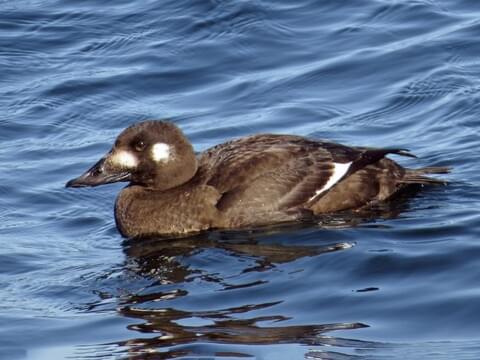
One of the easiest ways to spot the White-winged Duck is by the bold white patches on its otherwise dark wings, most visible in flight. This rare species prefers quiet forested wetlands in Southeast Asia, often hiding in shaded pools away from human activity. Sadly, it is endangered due to habitat loss and hunting, with only a few hundred left in the wild — making every sighting both special and significant.
2. White-winged Scoter (Male)
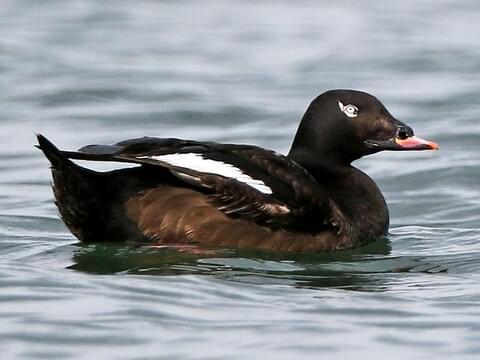
Male White-winged Scoters have striking white patches on the upper surface of their wings, contrasting sharply with their dark chocolate-brown to black bodies. These sea ducks are known for their haunting whistling wing sound during flight, especially when migrating along coastlines. They breed near northern freshwater lakes but spend winters on ocean waters, diving deep for mussels and clams.
3. Bufflehead (Male)
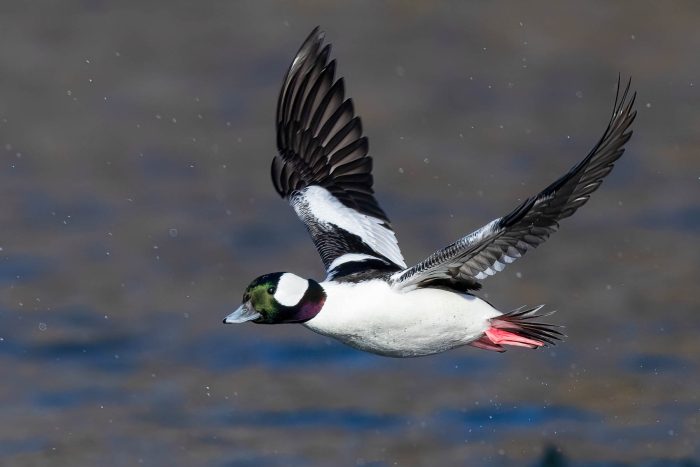
What makes the male Bufflehead stand out is the clean white wing patch that shows clearly in flight and even when folded, sitting against glossy black and iridescent plumage. Despite their tiny size, they migrate long distances from Canada to the U.S. and Mexico. Buffleheads nest in tree cavities—often old Northern Flicker holes—making them one of the smallest diving ducks to rely so heavily on woodpecker-made homes.
4. Black-bellied Whistling Duck
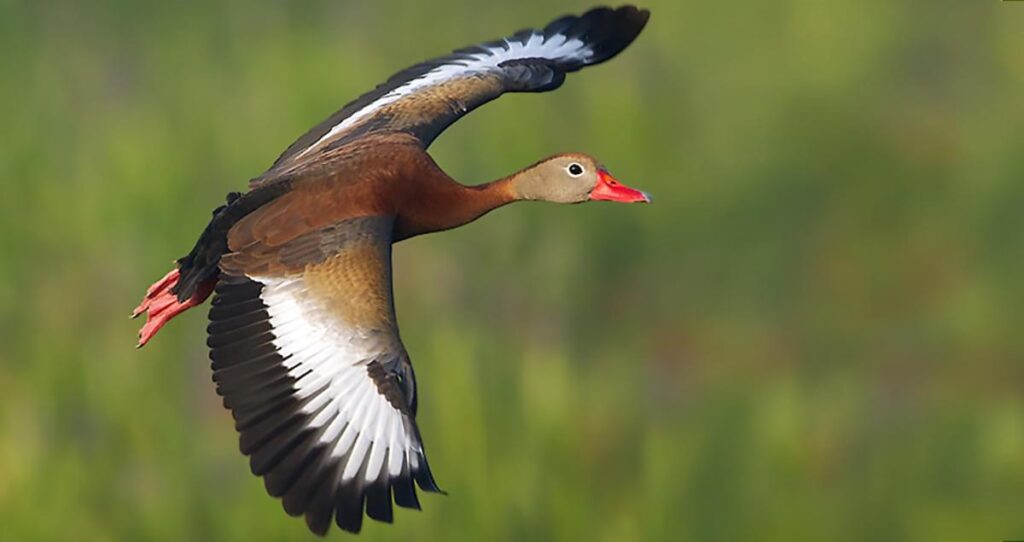
One curious feature of the Black-bellied Whistling Duck is the bright white patch on its wings that flashes clearly during flight, contrasting with its dark belly and chestnut body. These ducks are as noisy as their name suggests, producing high-pitched whistling calls while flying or even perching in trees. Unlike most ducks, they form strong pair bonds and often share parental duties, raising their young in tree cavities or nest boxes.
5. Tufted Duck (Male)
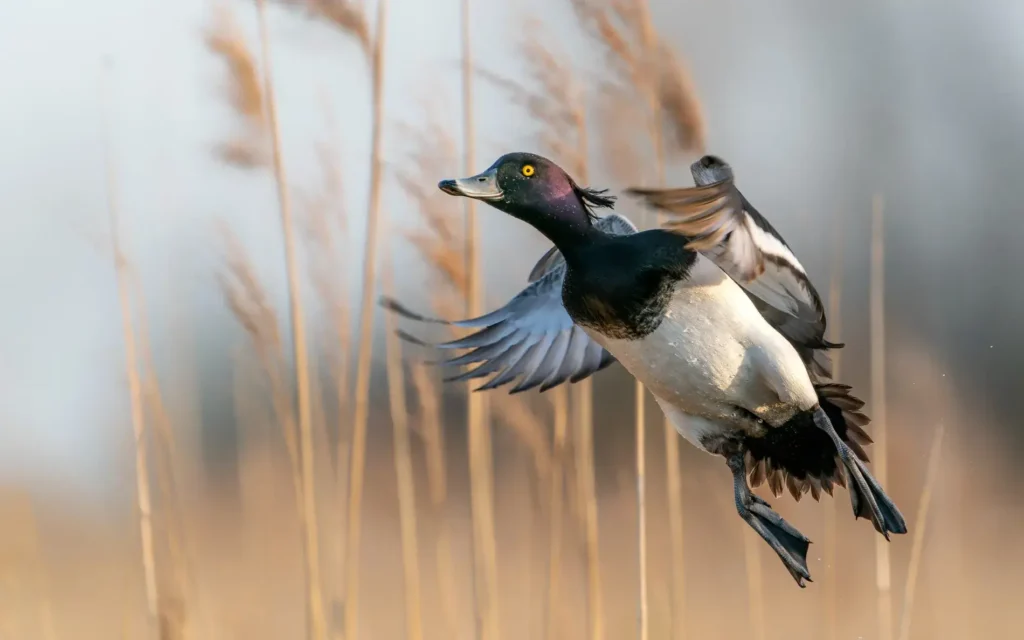
While resting, the Tufted Duck’s white wing patch is hidden, but once it takes flight, the bold white stripe across the upper wings becomes obvious against its black body and crisp white sides. These diving ducks are widespread across Europe and Asia and are known for their favorite wintering spots—calm lakes and coastal waters where they dive for mollusks and aquatic plants. The “tuft” of feathers hanging from the back of the male’s head adds extra character.
6. Common Merganser (Male)
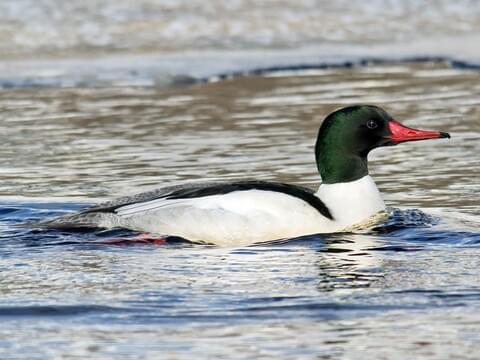
The male Common Merganser shows a sharp white wing panel that stands out when flying, bordered by dark upperwing feathers. These ducks are powerful fish hunters that often use their serrated bills to grip slippery prey. They prefer nesting in tree cavities along forested rivers and lakes, and ducklings famously leap from high tree nests just a day after hatching to follow their mother to water.
7. Canvasback (Male)
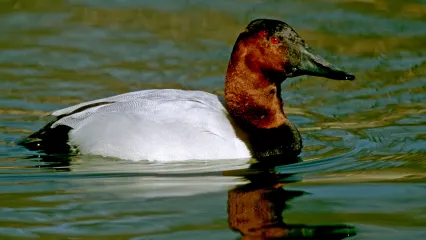
In flight, male Canvasbacks reveal a white back and lighter wings with grayish and white sections near the middle that stand out against their dark wing tips. Known for their sloping forehead and brick-red head, these ducks are strong migrants, flying from prairie potholes of North America to coastal bays in winter. Conservation efforts have helped the species recover from past population declines caused by habitat loss and hunting pressure.
8. Ring-necked Duck (Male)
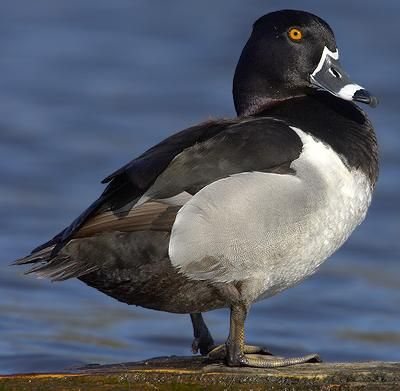
Despite its name, the “ring” on the neck is barely visible, but the male Ring-necked Duck carries a clear white stripe on its upper wings that flashes during flight. You’ll more easily notice the white ring around its bill, contrasted by its dark back and pale sides. These ducks are fond of freshwater ponds, especially those with lots of vegetation where they can dive for seeds and invertebrates. They’re also known for their fast, direct flight, making the white on their wings easy to spot when they take off abruptly.
9. Common Shelduck
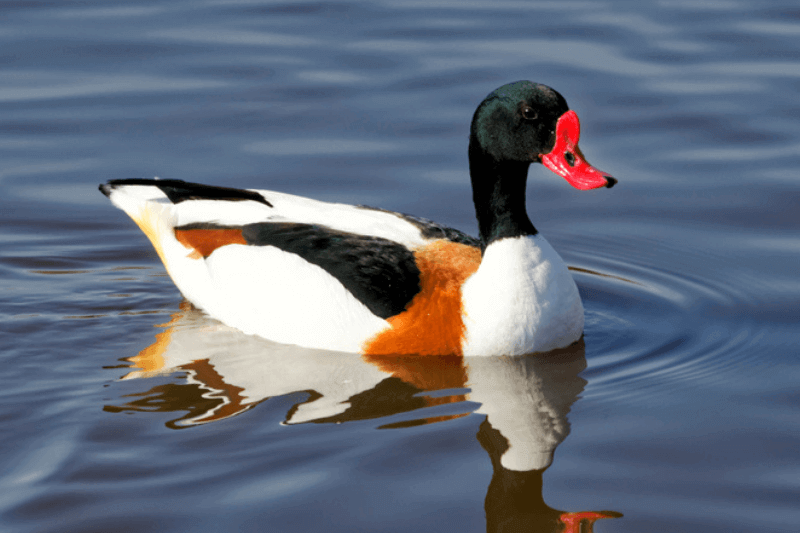
At first sight, the Common Shelduck’s wings stand out boldly with large white patches that cover most of the upper wing, contrasted by black flight feathers and a dark green head. Beyond appearance, this species prefers coastal mudflats and estuaries, where it feeds on small invertebrates. During molting season, thousands gather together in large groups, especially in places like the Wadden Sea in Europe.
10. Paradise Shelduck
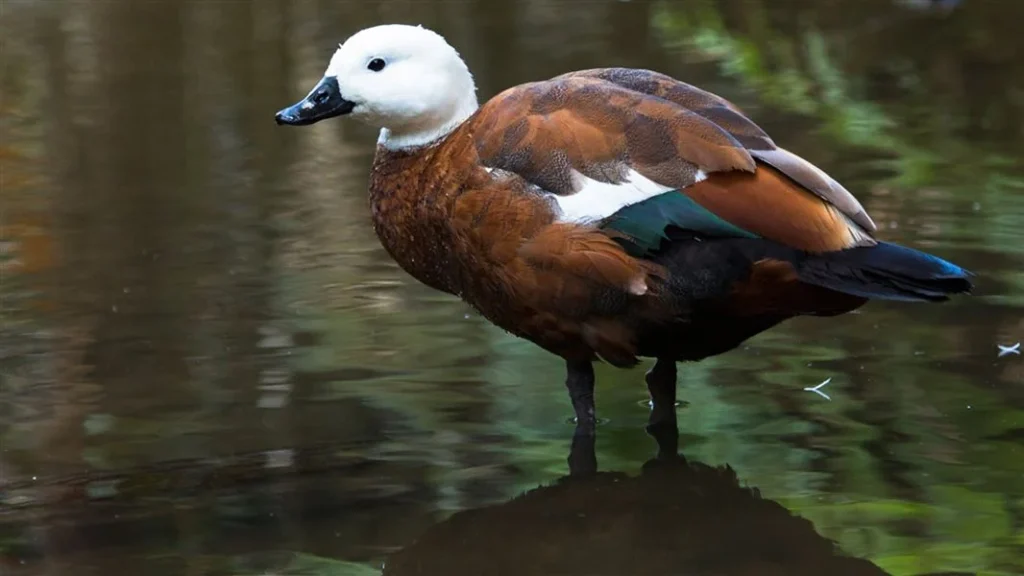
In flight, the male Paradise Shelduck displays a bright white wing area that contrasts with its otherwise dark body, while females show white wings paired with a white head. Native to New Zealand, these ducks are unique because females are more colorful than males—opposite of most duck species. They are also known for their loud, honking calls that echo across farmland and open wetlands.
11. Ruddy Shelduck
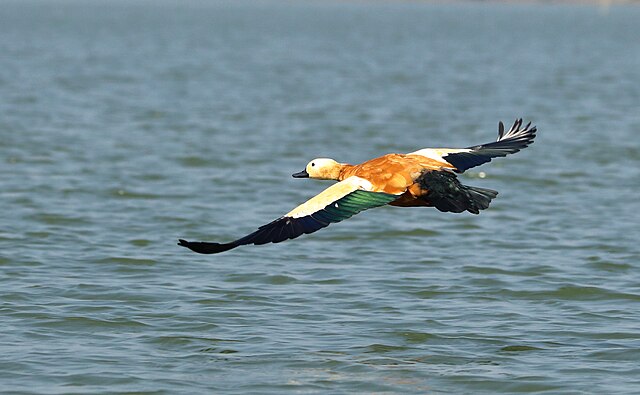
When the Ruddy Shelduck takes off, broad white wing panels bordered by black tips become clearly visible. These cinnamon-orange ducks are often found around lakes and rivers in Asia and Eastern Europe, and many cultures consider them symbols of fidelity because they mate for life. They prefer nesting in cliffs, tree holes, or even abandoned buildings rather than directly on water.
12. Greater Scaup
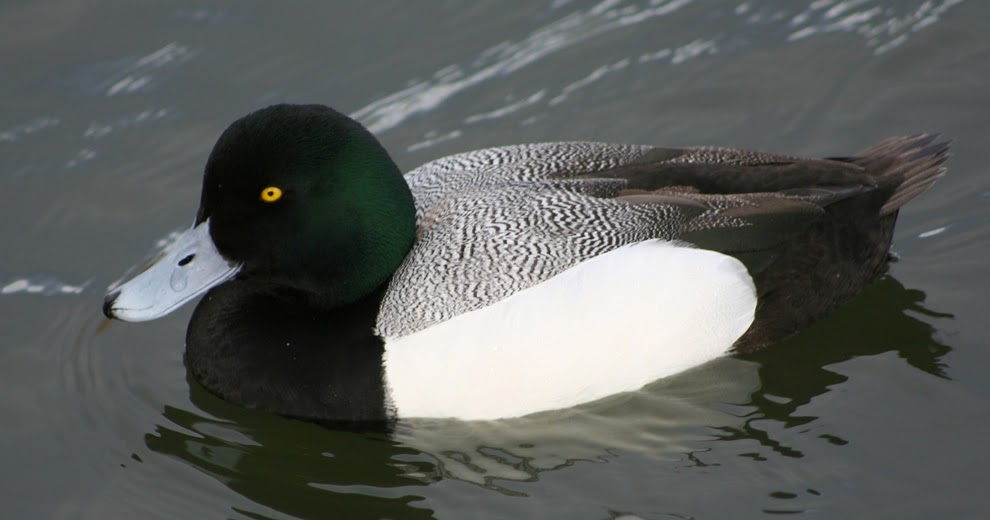
The Greater Scaup flashes a white wing stripe that extends far into the primary flight feathers when flying—one of the easiest ways to tell it apart from similar species. These ducks spend winters on coastal waters and dive to feed on mollusks and aquatic plants. Large winter flocks, sometimes numbering in the thousands, are a familiar sight across the North Atlantic coasts.
13. Lesser Scaup
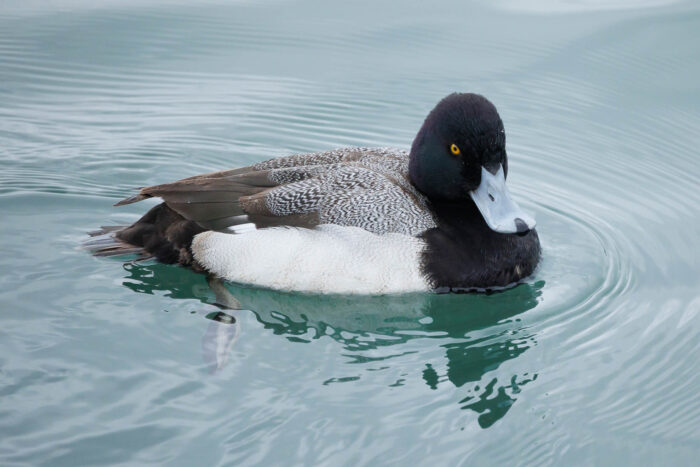
Though similar to the Greater Scaup, the Lesser Scaup’s white wing stripe is shorter and does not reach as far into the primary feathers. This subtle difference helps birders tell them apart during flight. Also called “little bluebills,” they are the most abundant diving duck in North America and migrate in huge flocks. They favor freshwater lakes and reservoirs rather than coastal seas during migration and winter.
14. Common Goldeneye
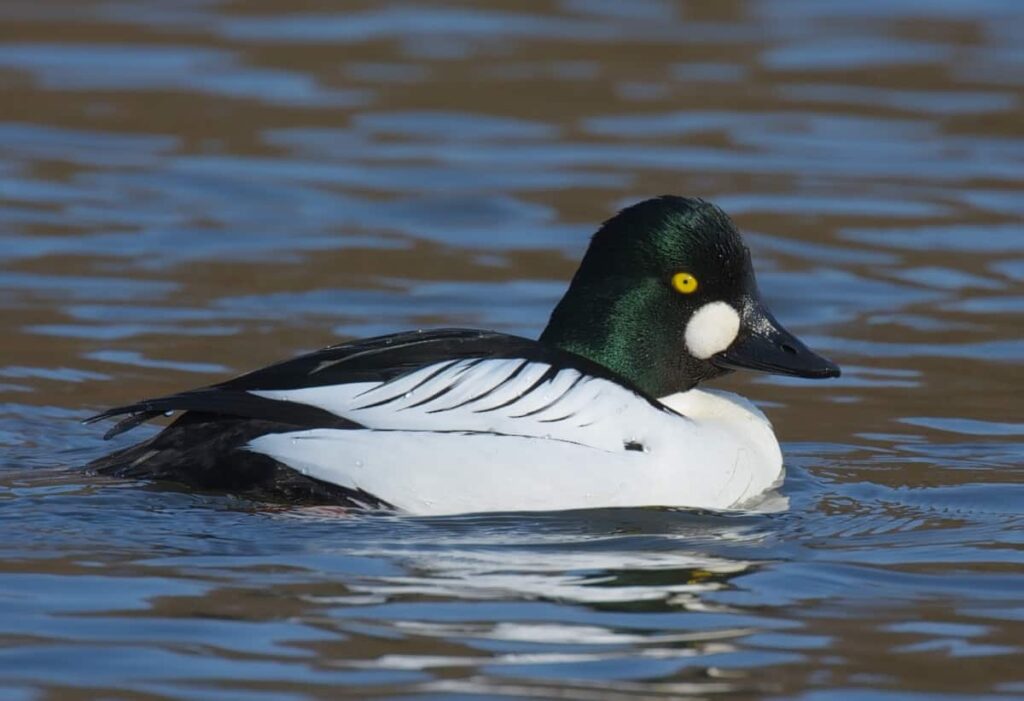
When the Common Goldeneye takes flight, its wings reveal a clean white patch across the inner portion of the wing, sharply separated by black outer feathers. Aside from their striking plumage, these ducks are known for their whistling wing sound during flight—earning them the nickname “whistlers.” They nest in tree cavities, often far from water, and ducklings leap from heights just a day after hatching.
15. Barrow’s Goldeneye (Male)
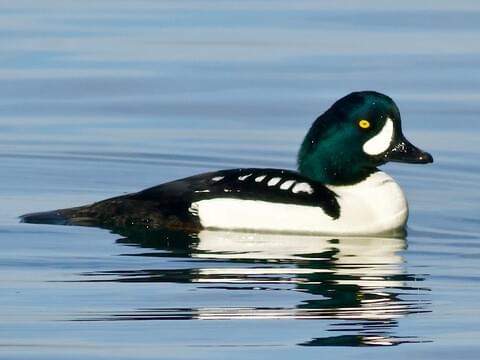
The male Barrow’s Goldeneye shows bright white wing panels when flying, though these are edged with black and set against glossy dark feathers. What makes this species unique beyond its appearance is its preference for fast-flowing mountain lakes and streams in the breeding season. They are more territorial than Common Goldeneyes and often return to the same nesting area year after year.
16. Bufflehead (Male)

Male Buffleheads display bold white wing patches that are visible both at rest and especially in flight, accentuated against their glossy black backs and iridescent head. These tiny divers are the smallest sea ducks in North America. They rely heavily on old tree holes made by Northern Flickers for nesting and are also known for their quick, direct wingbeats when flying.
17. Smew
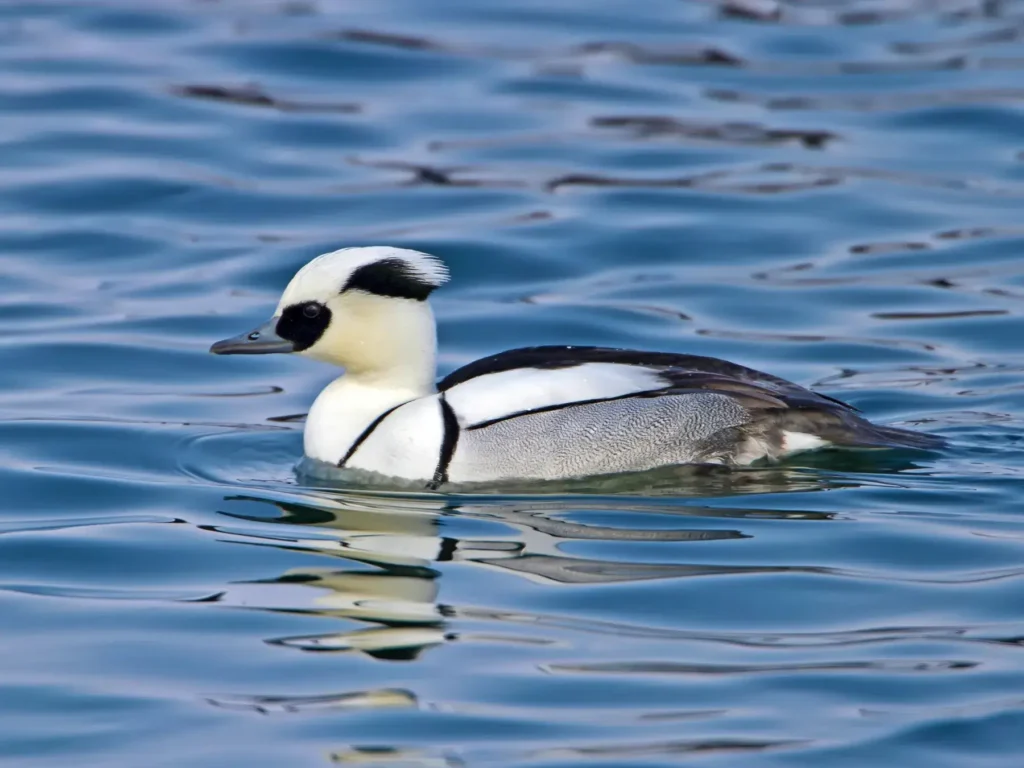
The Smew stands out with black-and-white “checkerboard” wings that show clear white panels bordered by dark edges during flight. Beyond its striking looks, this small European and Asian duck is known for its quiet and shy behavior, often hiding in reeds and only taking flight when necessary. It is one of the few ducks that nests in tree cavities and winters on ice-free lakes and river estuaries.
18. Red-breasted Merganser
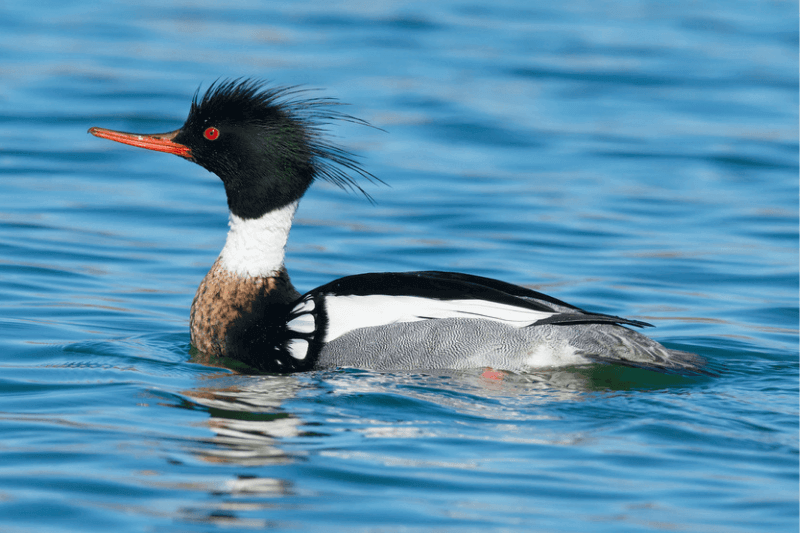
In flight, the Red-breasted Merganser reveals white wing patches along the inner wing, sharply marked by black outer feathers. One fascinating trait is their incredible speed—they are considered one of the fastest-flying ducks, reaching speeds over 100 km/h (62 mph). These ducks prefer coastal waters in winter and are expert fish hunters, using serrated bills to grip slippery prey.
19. Long-tailed Duck
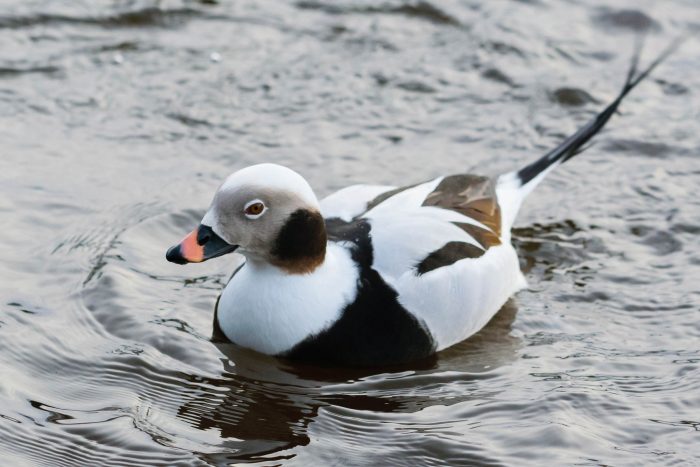
While swimming, their wings don’t show much, but once in flight, Long-tailed Ducks reveal white patches on the upper wings surrounded by darker feathers. These ducks are incredible deep divers—capable of plunging over 200 feet underwater to catch small mollusks and crustaceans.
20. Gadwall
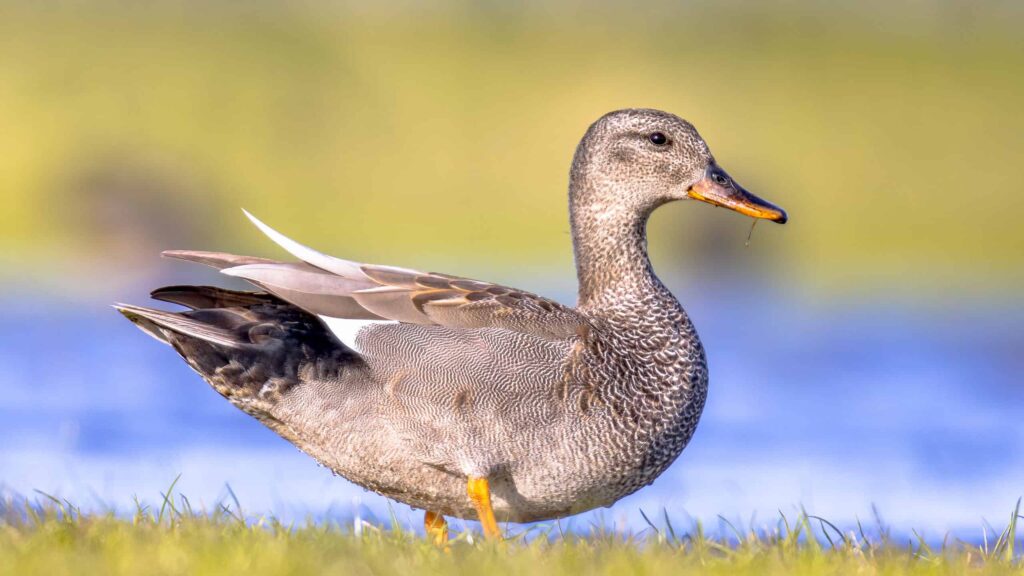
Gadwalls may look plain from a distance, but when they open their wings, you’ll see a clear white wing patch (speculum) on the inner wing, contrasting with gray and black feathers. Unlike many dabbling ducks, they often steal food from other birds, especially coots—earning them a reputation as quiet but clever opportunists.
21. American Wigeon (Male)
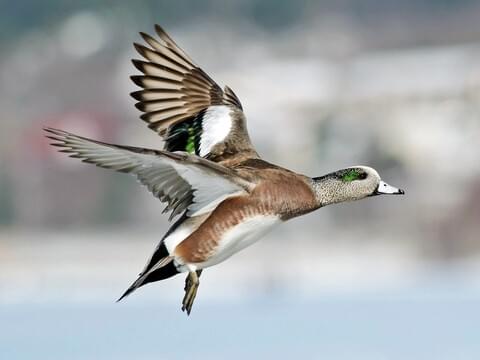
Male American Wigeons show bright white patches on the upper wings during flight, paired with a dark trailing edge. Aside from their plumage, their high-pitched whistling call is one of the most distinctive sounds in wetlands during migration and winter.
22. Eurasian Wigeon (Male)
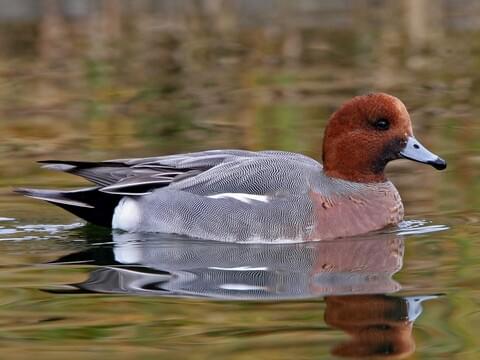
The male Eurasian Wigeon also displays white upper wing panels with grayish flight feathers that flash during flight. Instead of the whistling heard in the American species, these birds produce a softer, two-note “whee-ooo” call and are commonly seen grazing on land like geese.
23. Common Eider
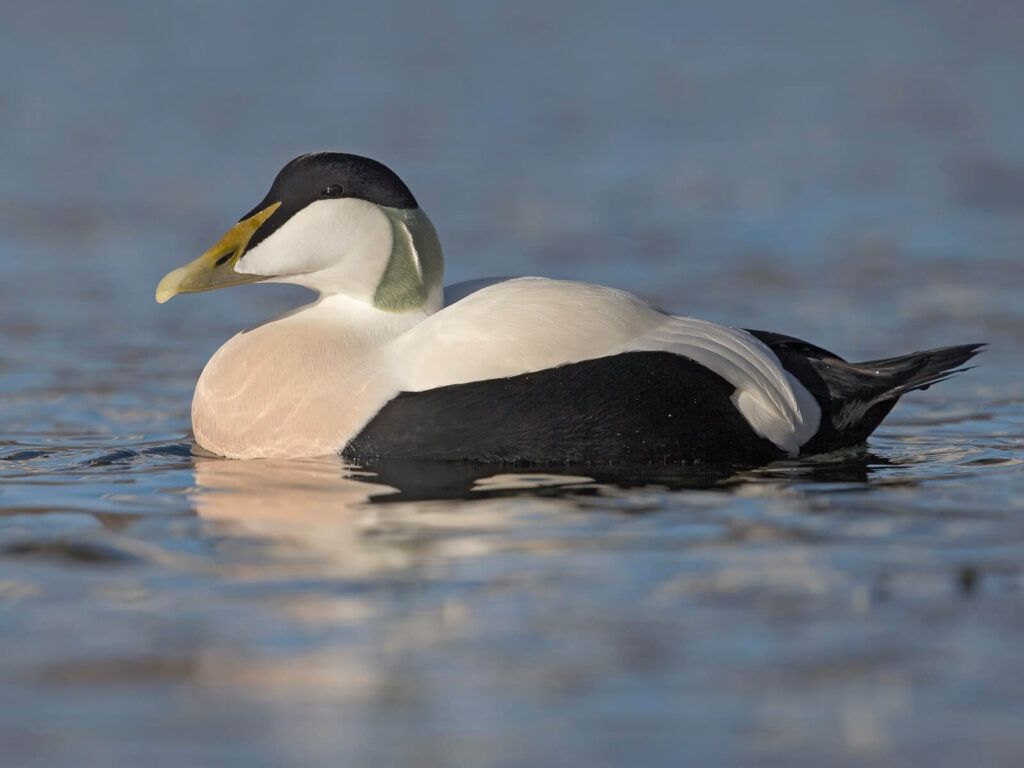
In flight, male Common Eiders show white wing coverts contrasted with black flight feathers, making the wings stand out clearly. These sea ducks are known for producing the softest down in the world—Eiderdown—which they pluck from their own bodies to line nests and keep eggs insulated.
24. King Eider
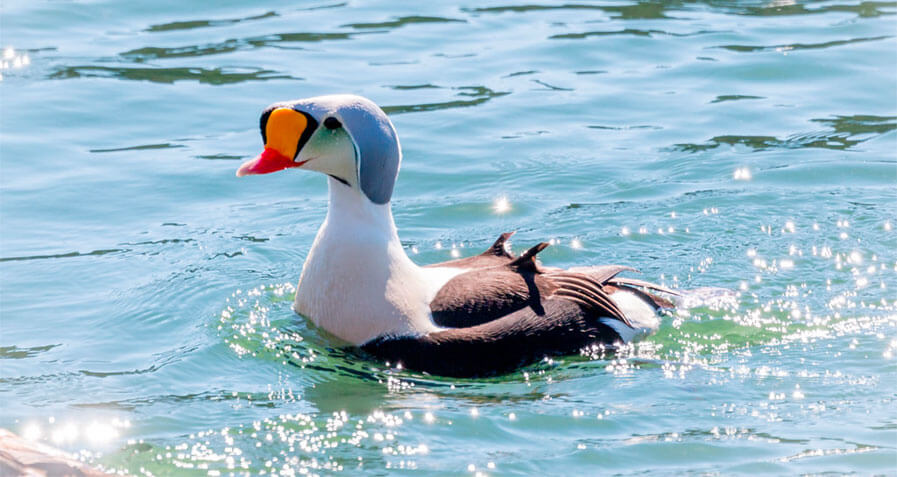
Male King Eiders often reveal white on the inner wings during flight, framed by black outer feathers. What makes them fascinating is their survival in icy Arctic waters; they often gather in huge flocks around sea ice, diving for clams and mussels in frigid seas.
25. Steller’s Eider
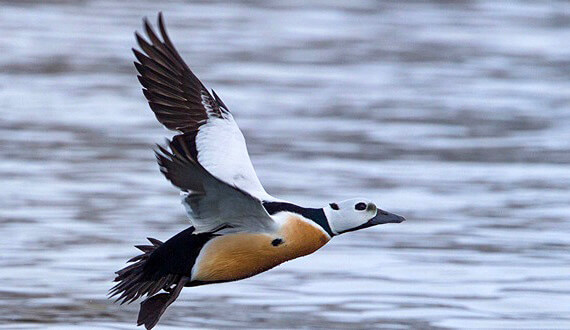
Steller’s Eiders show a distinctive white wing patch edged with black when they take off or stretch their wings. They are the smallest eider species and sadly one of the most threatened, with declining populations due to habitat loss and changing Arctic conditions.
26. Mallard (Male)
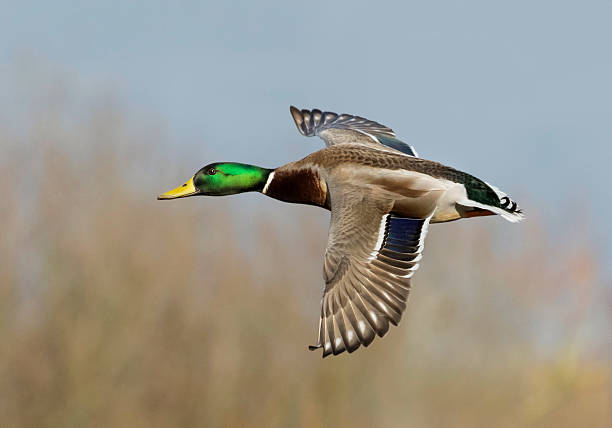
Male Mallards don’t appear to have white wings when resting, but in flight or when they stretch their wings, you can see a white border around their blue-purple speculum. These ducks are incredibly adaptable and can be found in city parks, farm ponds, lakes, and even urban fountains—one reason they are among the most widespread ducks in the world.
27. Ancona Duck
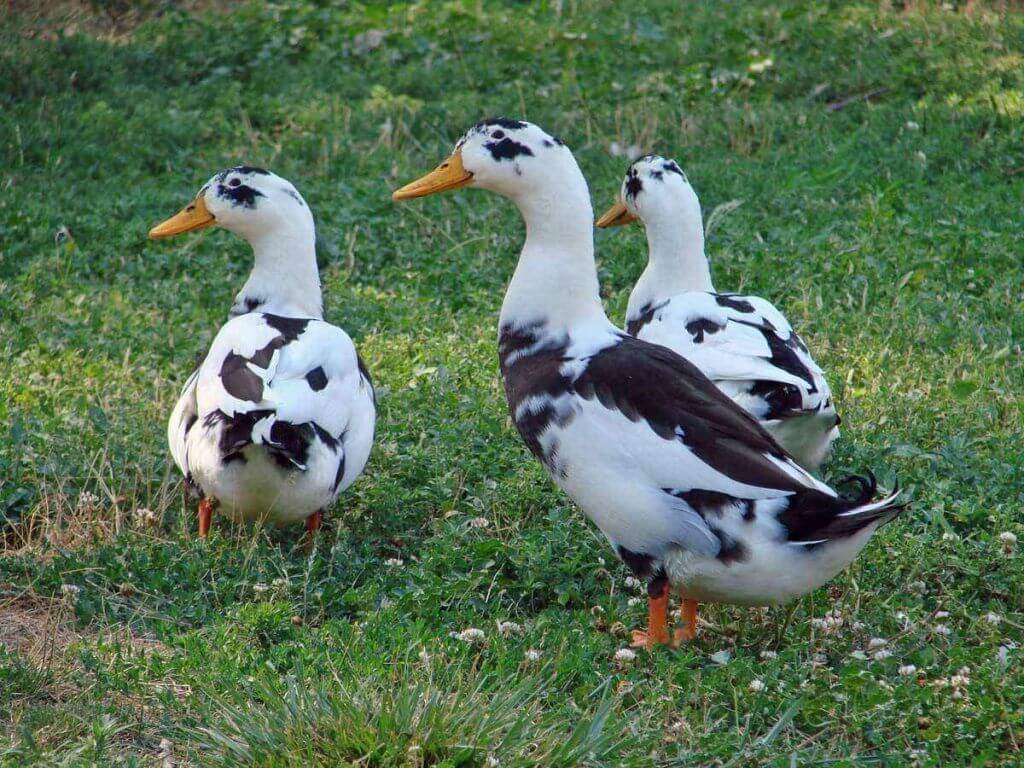
Ancona Ducks usually have patches of white on their wings mixed with black, chocolate, or blue depending on the individual bird. They are calm, friendly domestic ducks known for their excellent egg-laying ability, often producing over 200 eggs per year.
28. Magpie Duck
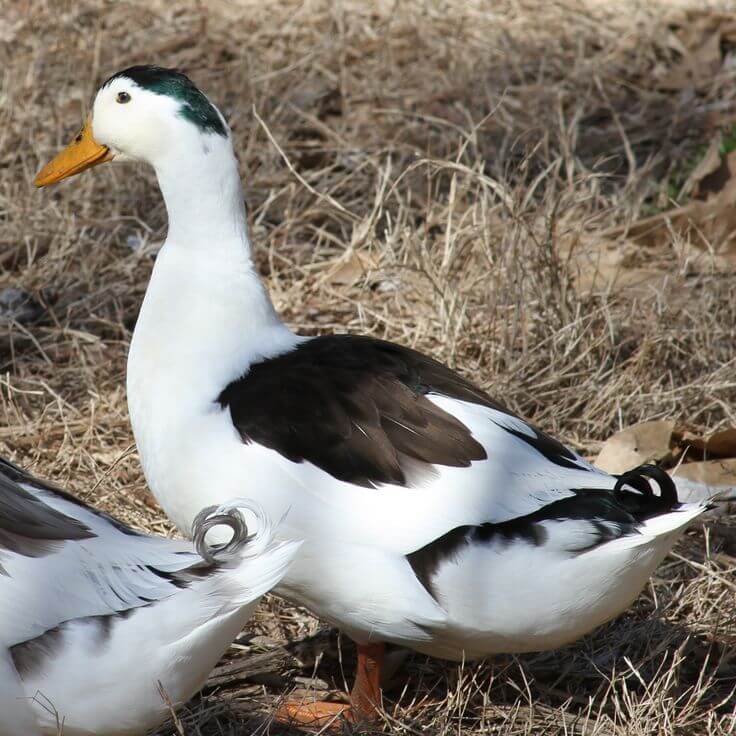
Magpie Ducks have a striking black-and-white body pattern, and their wings often feature white patches or mostly white feathers depending on the color strain. These ducks are active foragers and are often kept on farms because they help control pests like snails and insects.
29. Call Ducks
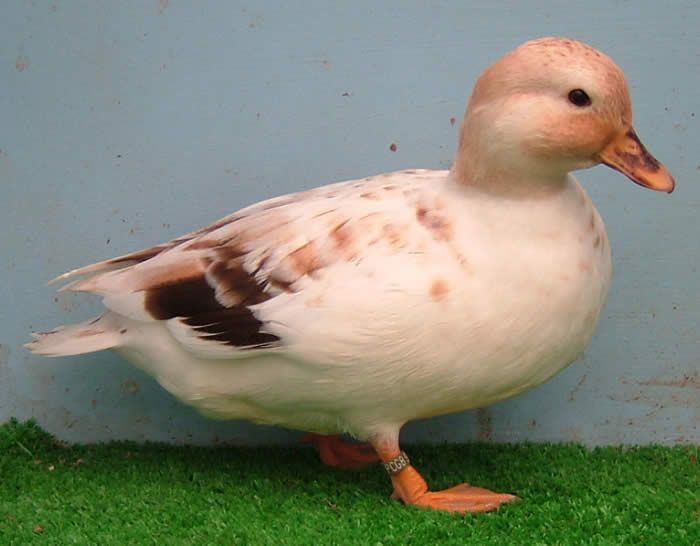
Call Ducks, especially the white or pied variations, often show white on their wings or wing bars. Originally bred as decoy ducks to attract wild waterfowl, they are now popular as pets due to their small size and surprisingly loud, high-pitched quacks.
30. Some Muscovy Ducks
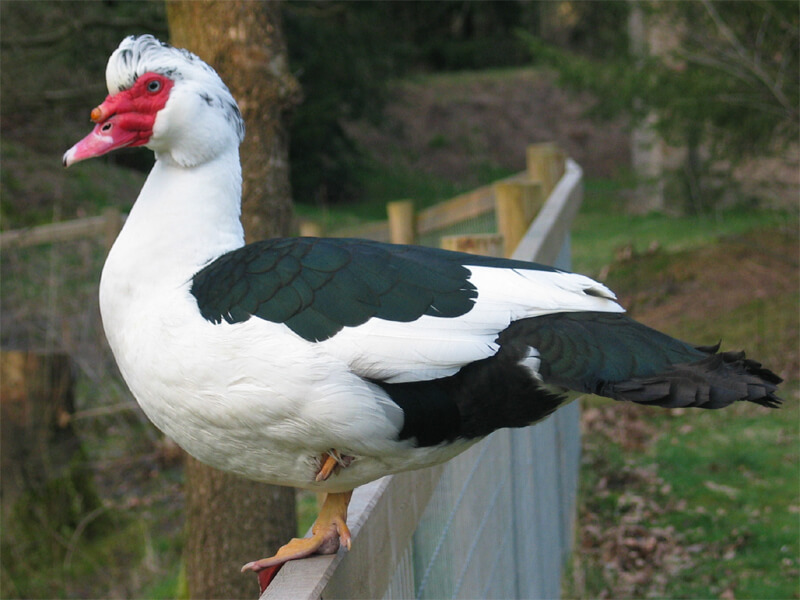
Certain Muscovy Ducks—especially domesticated or pied varieties—have large white patches on their wings mixed with black or iridescent green. Unlike most ducks, Muscovies don’t quack; instead, males hiss while females make soft trills, making their vocal behavior quite unique.
